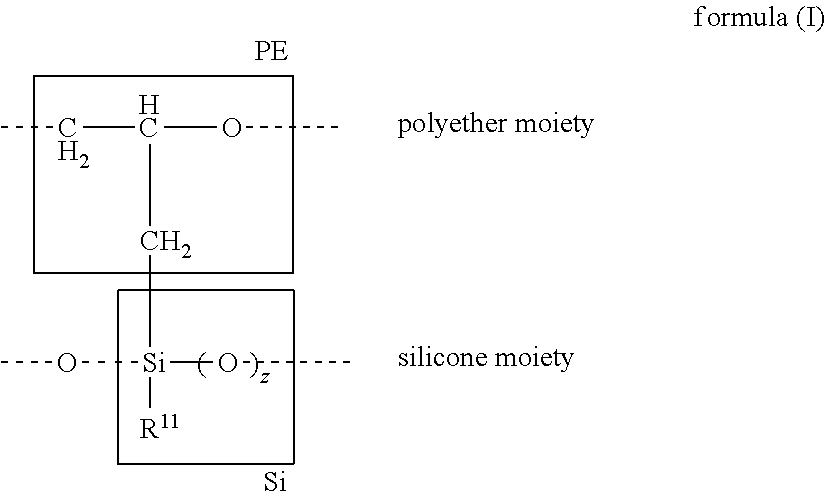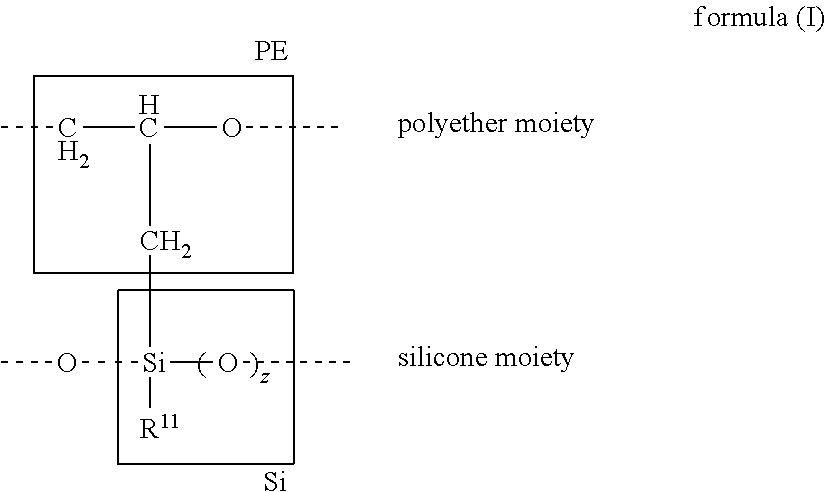Silicone polyethers and preparation thereof from polyethers bearing methylidene groups
a technology of polyethers and methylidene groups, which is applied in the field of silicon polyethers, can solve the problems of molar mass build-up and development of odour, unsolved odour taint due to the hydrolytic release of propionaldehyde, and the product odour
- Summary
- Abstract
- Description
- Claims
- Application Information
AI Technical Summary
Benefits of technology
Problems solved by technology
Method used
Image
Examples
example 1
Preparing the Polyether-Silicone Compounds of the Present Invention
synthesis example s1
[0171]21.8 g of 1,1,1,3,5,5,5-heptamethyltrisiloxane and 70.0 g of methylidene polyether VP-1 were mixed with each other. The reactants were heated to 70° C. and admixed with 91.8 mg of a solution of the Karstedt catalyst in decamethylcyclopentasiloxane (w (Pt)=1.0%). The reaction mixture was stirred at 70° C. for 2.5 hours and then devolatilized for three hours at 130° C. and 13C and 1H NMR spectrum. According to 29Si NMR analysis, the molar ratio of M:DPE is 2:1.
Synthesis Example S2
[0172]51.1 g of a siloxane having a molar mass distribution and comprising on average 6 Si units as per the general formula Me3SiO[SiMe2O]3[SiHMeO]1SiMe3 and 80.0 g of methylidene polyether VP-2 were mixed with each other. The mixture of reactants was heated to 80° C. and admixed with 131 mg of a solution of the Karstedt catalyst in decamethylcyclopentasiloxane (w (Pt)=1.0%). The reaction mixture was stirred at 100° C. for 2.5 hours. At the end of this period, a gel was obtained. The constituents of the...
synthesis example s3
[0173]25 g of the product of Example S1 were admixed with 5 g of decamethylcyclopentasiloxane and 0.03 g of tetramethylammonium hydroxide pentahydrate. The mixture was stirred at 70° C. for six hours. A clear liquid product was obtained. Free methylidene groups are undetectable in the 13C NMR spectrum. According to 29Si NMR analysis, the molar ratio of M:D:DPE is 2:3.2:0.9.
PUM
| Property | Measurement | Unit |
|---|---|---|
| molar mass | aaaaa | aaaaa |
| mol % | aaaaa | aaaaa |
| valence | aaaaa | aaaaa |
Abstract
Description
Claims
Application Information
 Login to View More
Login to View More - R&D
- Intellectual Property
- Life Sciences
- Materials
- Tech Scout
- Unparalleled Data Quality
- Higher Quality Content
- 60% Fewer Hallucinations
Browse by: Latest US Patents, China's latest patents, Technical Efficacy Thesaurus, Application Domain, Technology Topic, Popular Technical Reports.
© 2025 PatSnap. All rights reserved.Legal|Privacy policy|Modern Slavery Act Transparency Statement|Sitemap|About US| Contact US: help@patsnap.com


